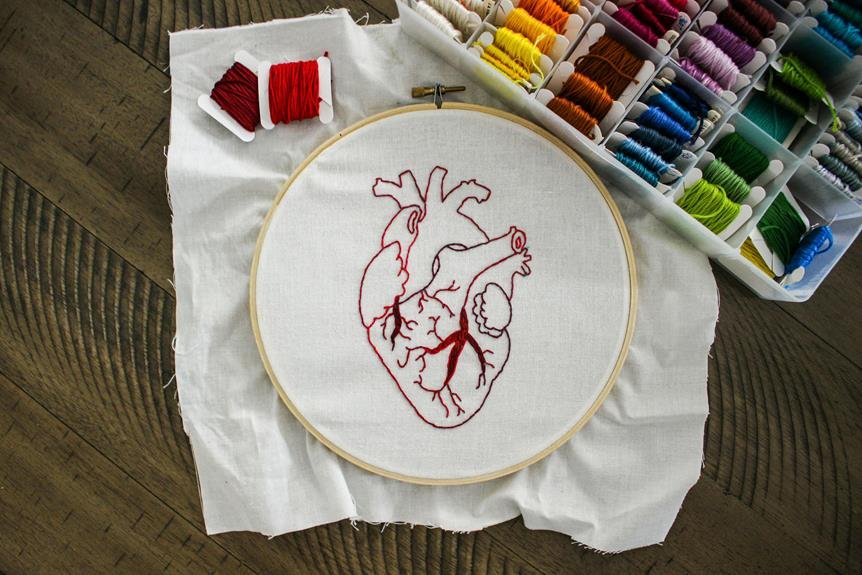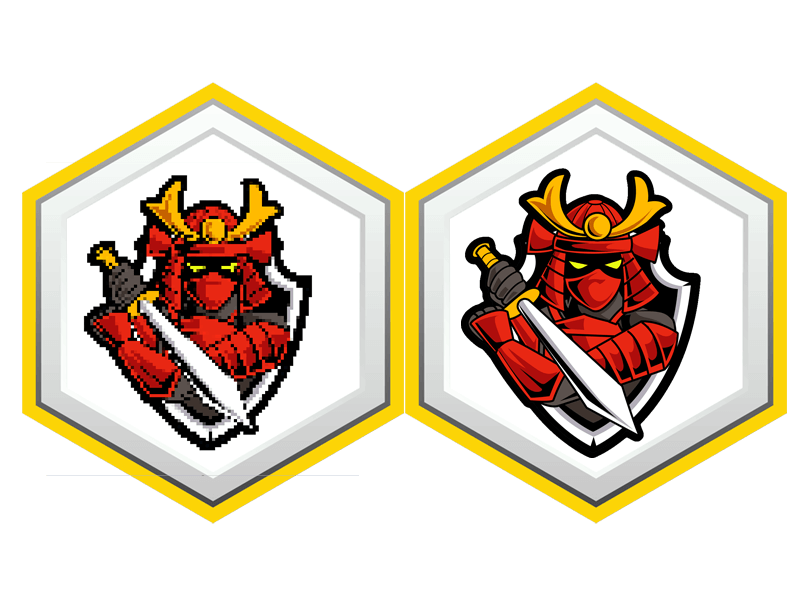When comparing sewing and embroidery, sewing focuses on joining fabrics with basic stitches, while embroidery involves creating decorative designs using specialized threads. Sewing emphasizes functionality and durability, while embroidery highlights intricate patterns and aesthetic appeal. Sewing is suitable for beginners with basic stitching techniques, while embroidery demands higher skill due to precision in intricate designs. Sewing machines excel at producing clean seams, while embroidery machines cater to elaborate designs. If you want to explore further into the differences and similarities between sewing and embroidery, discover how each craft offers unique opportunities for creative expression and personalization.
Key Takeaways
- Sewing is primarily functional, focusing on joining fabrics with durable stitches.
- Embroidery leans towards decoration, creating intricate designs with specialized threads.
- Sewing is suitable for beginners with basic stitching techniques.
- Embroidery demands higher skill levels for precision in intricate designs.
- Both crafts offer creative possibilities, allowing for unique and personalized fabric creations.
Crafting Techniques Overview
When delving into the crafting techniques overview of sewing versus embroidery, it's important to understand the distinct processes involved in each. Embroidery involves creating decorative designs on fabric using needles and specialized threads. The focus here is on intricate patterns and embellishments that add a unique touch to the fabric. To achieve this, digitized designs are used along with embroidery machines that help in creating precise and detailed work.
On the other hand, sewing is primarily about joining fabrics together using stitches. While embroidery is more about aesthetics, sewing serves functional purposes, especially in garment construction. Unlike embroidery, sewing can be done by hand or with the help of a sewing machine, making it a versatile craft in its own right.
Both crafts require attention to detail and precision, but they cater to different aspects of fabric manipulation. Embroidery adds artistic flair with its designs, while sewing forms the backbone of constructing wearable pieces. The choice between the two techniques often depends on the desired outcome and the purpose of the project.
Material Usage Variances
In comparing the material usage variances between sewing and embroidery, it is important to understand the distinct purposes for which threads are employed in each craft. Sewing projects primarily utilize threads for functional purposes such as joining fabric pieces together, while embroidery threads are used for decorative stitches to create intricate designs. The types of stitches in sewing are focused on durability and strength, whereas in embroidery, threads like silk, gold, and silver are chosen for their aesthetic appeal and embellishment.
Here is a comparison of the material usage variances between sewing and embroidery:
| Material Usage Variances | Sewing | Embroidery |
|--------------------------|--------------------------------------------|------------------------------------------------------|
| Types of Stitches | Straight, zigzag, overcasting stitches | Satin, running, back, and chain stitches |
| Threads | Strong and durable | Silk, gold, silver, for aesthetic purposes |
| Equipment | Sewing machine | Embroidery machine |
Understanding these differences in material usage is important for selecting the right tools and threads for your sewing or embroidery projects.
Skill Level Requirements
To gauge proficiency in sewing and embroidery, assess the required skill levels for each craft. Sewing primarily involves basic stitching techniques and pattern assembly, making it suitable for beginners. It focuses on functional construction elements such as seams and hems, which are relatively straightforward for novices to grasp.
On the other hand, embroidery necessitates a higher skill level due to its intricate designs and precise thread placement requirements. Embroidery demands a keen eye for detail and precision in executing complex designs. While beginners may find sewing easier to start with, especially because of its simpler stitching techniques, mastering embroidery requires more practice and patience. The stitching techniques in sewing are generally easier to learn and perfect compared to the more intricate and detailed work involved in embroidery.
Considering skill level requirements, embroidery is typically viewed as more advanced and challenging compared to sewing.
Design Possibilities Comparison
With embroidery offering limitless design possibilities and sewing focusing on functional stitches, a comparison of their design potential reveals distinct creative avenues for enthusiasts. Embroidery shines as a creative outlet, allowing for intricate patterns, detailed motifs, and decorative embellishments like monograms and 3D foam designs.
It's a constructive craft where the primary focus is on the artistry and aesthetics of the designs rather than the functionality. On the other hand, sewing is more about creating functional craft items through precise stitching and seams for garment construction. Sewing machines excel at producing clean and precise functional seams and hems, emphasizing practicality over ornamental design.
While both sewing and embroidery involve working with fabrics, embroidery machines specialize in decorative and ornamental designs, whereas sewing machines are geared towards constructing garments and other functional items. Enthusiasts of both crafts can explore a wide range of designs and patterns, each offering its unique set of creative possibilities.
Time and Patience Needed
When it comes to embroidery, you'll find that it demands more time and patience compared to sewing.
The intricate designs require meticulous attention and precision throughout the stitching process.
Your patience will be rewarded with beautifully detailed creations that showcase your dedication and skill.
Skill Level Required
Learning embroidery demands more time and patience compared to sewing due to its intricate designs and detailed stitching techniques. While sewing focuses on functional stitches and patterns that are relatively easy to grasp, embroidery requires a higher skill level due to its complex decorative elements. Here is a comparison of the skill levels needed for sewing and embroidery:
| Skill Level | Sewing | Embroidery |
|-------------|----------------|----------------------|
| Complexity | Less intricate | More intricate |
| Time Required | Quick to learn | Time-consuming |
| Precision | Basic stitches | Detailed stitching |
Embroidery, being done by hand, demands precision and attention to detail, making it a craft that requires dedication and practice to master.
Precision and Detail
To excel in embroidery, you must hone your precision and attention to detail, as these qualities are essential for crafting intricate designs that stand out on fabric. Embroidery demands meticulous work to create detailed patterns that showcase the beauty of the craft.
Precision in embroidery is paramount for achieving the desired effect and ensuring the final product is visually appealing. Unlike sewing, which focuses on functional stitches and strong, durable seams for practical purposes, embroidery leans more towards intricate designs that require time and patience to perfect.
The time-consuming nature of embroidery comes from the need to meticulously stitch each detail, resulting in stunning and elaborate creations that highlight the artistry and skill involved in this craft.
Functional Vs Decorative Focus
With a distinct emphasis on either functionality or decoration, sewing and embroidery showcase contrasting focuses in textile arts. Sewing primarily involves joining fabric pieces and creating seams, emphasizing essential aspects necessary for constructing garments and other wearable items. On the contrary, embroidery revolves around decorative elements, adding intricate designs and patterns to fabrics to enhance their aesthetic appeal.
While sewing is vital for ensuring durability and functionality in clothing and accessories, embroidery serves to personalize and beautify the fabric, focusing on creativity and embellishment. Sewing is fundamental for creating practical, everyday items, emphasizing utility and construction. In contrast, embroidery plays a key role in adding unique, artistic touches to textiles, highlighting the decorative aspect of the craft.
Equipment Variances
In sewing and embroidery, the equipment variances play a crucial role in determining the tools needed for each craft's distinct processes.
Sewing requires needles, threads, fabric, and a sewing machine, commonly found in households for garment production.
On the other hand, embroidery utilizes needles, threads, fabric, and embroidery machines, specifically designed for intricate and large-scale designs.
The needles used in both crafts serve the purpose of stitching, with sewing focusing on functional construction and embroidery on decorative embellishments.
When it comes to threads, embroidery threads like silk, gold, and silver are chosen for their aesthetic appeal, while sewing threads are selected for their strength and durability.
Sewing threads are primarily functional, whereas embroidery threads are ornamental.
These differences in equipment highlight the specific needs of each craft, with sewing machines being versatile for various fabric manipulations, while embroidery machines cater to the intricate designs and embellishments used in embroidery projects.
Personal Expression Opportunities
Choosing between sewing and embroidery for personal expression allows you to explore design freedom in sewing and artistic flair in embroidery. Both crafts offer creative possibilities that abound, providing you with avenues to showcase your unique style preferences.
Whether you prefer intricate stitches in embroidery or custom garment construction in sewing, there are endless opportunities to express your creativity through these versatile mediums.
Design Freedom in Sewing
Sewing in itself offers a canvas for boundless creativity and self-expression through fabric manipulation and garment construction techniques. Design freedom in sewing allows you to achieve custom fits, unique styles, and tailored pieces that suit your individual preferences.
With sewing patterns, you have the flexibility to customize details such as hem lengths and embellishments like buttons or lace, enabling you to create personalized garments. Personal expression opportunities extend to creative seam finishes, decorative stitches, and inventive fabric combinations that give your creations a distinctive touch.
Through sewing, you can showcase your creativity and originality by designing and crafting one-of-a-kind clothing and accessories that reflect your unique style and personality.
Artistic Flair in Embroidery
Exhibiting intricate detail and artistic finesse, embroidery offers a compelling avenue for personal expression through fabric embellishment. With a vast array of embroidery stitches like satin stitch, chain stitch, and French knot at your disposal, you can harness your creativity to infuse your creations with unique charm and intricate designs.
The use of different thread colors and textures further enhances your ability to add personalized embellishments, making each piece truly one-of-a-kind. Artistic flair in embroidery empowers you to unlock your creativity, enabling you to craft visually stunning works that reflect your individual style and personality.
Embrace the endless possibilities of embroidery to showcase your artistic talents and create masterpieces that speak volumes about your artistic vision.
Creative Possibilities Abound
Discover a world of endless creative possibilities by exploring the personal expression opportunities that both sewing and embroidery offer through intricate designs and patterns.
Embroidery usually involves creating intricate designs on fabric, adding a decorative touch to items. On the other hand, sewing and embroidery combined allow you to customize garments with unique stitching techniques and fabric choices.
Whether you prefer the artistic flair of embroidery or the functional aspects of sewing, both crafts enable you to showcase your individual style and creativity.
By incorporating embroidery into your sewing projects, you can create garments and accessories that aren't only personalized but also stand out with a touch of handmade artistry.
Let your imagination run wild as you explore the creative avenues that sewing and embroidery offer.
Conclusion
To sum up, sewing and embroidery both offer unique opportunities for creativity and personal expression. While sewing focuses on creating functional items, embroidery allows for intricate and decorative designs.
Both crafts require patience, skill, and the right equipment. Whether you prefer the practicality of sewing or the artistic flair of embroidery, both techniques offer endless possibilities for creating beautiful and unique pieces.
So, pick up a needle and thread, and let your creativity soar!


